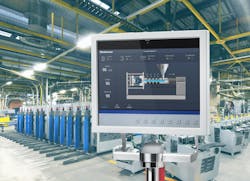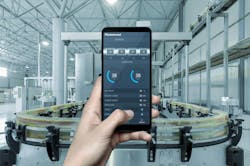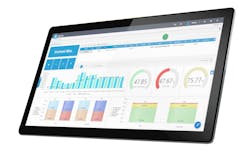The expanding quantity of Industrial Internet of Things (IIoT) devices, in conjunction with improved computing and communication capabilities, means there is an astounding variety of data sources available to the manufacturing industries. However, the work required to bidirectionally access factory-level data and then wrest value and efficiency from it through business systems can be a complex proposition.
In Europe, the sedApta group is an experienced MES/MOM (manufacturing execution system/manufacturing operations management) supplier with clients in food, paper, plastics, fashion and other manufacturing industries. For years they followed a traditional approach of performing custom work for each project to integrate their products with an expansive range of client technologies. To overcome the time, cost, complexity and risk involved with this methodology, they identified a unified data and visualization platform to fulfill this role and accelerate their efforts to deliver projects.
The data dilemma
Beyond the fact that industrial data sources needed for MES/MOM projects involve a range of technologies that can often be many years old, the data of interest does not have a single format. As a result, finding the data, processing it as needed and routing it to the place where it will be used can be an onerous task.
Human-machine interface (HMI) and supervisory control and data acquisition (SCADA) systems are designed to manage these data flows and visualize the information in real-time for maintaining safe and reliable operations, while also archiving the information. However, every client prefers their own flavor of HMI/SCADA, and many plant floor systems arrive pre-packaged with dedicated small controllers and HMIs.
While MES/MOM technologies do not always require real time data, they do need the proper data presented to and extracted from sources in a unified format. To accomplish this with every unique project they executed, sedApta needed to extract the 5% to 10% of meaningful data from all the data generated on the shop floor and intermediate systems and then process it up to the supervisory software for production optimization.
To address the challenge, sedApta needed to develop a common data acquisition system (DAS) interface layer to provide a single consistent, yet flexible data environment between the operating facility equipment and MES/MOM (Figure 1). This intermediate-layer DAS would need to aggregate data from all sources, provide pre-processing to add meaning and context for the data, and present itself as a single interface/toolset for ease-of-use.
The DAS was envisioned as a standalone software platform suited for connecting with plant floor assets and with supervisory or cloud-based MES/MOM resources. The aim was to connect the MES/MOM software with objective, safe and reliable data, guaranteeing the quality and timeliness of the data to provide comprehensive information supporting the analysis and planning of corrective actions directed at improving efficiency, optimizing production and product quality.
After significant analysis, sedApta selected Emerson Movicon.NExT HMI/SCADA and data connectivity software as the core platform for its DAS because of the following features:
- I/O data server support for any data type definition, including the widely used OPC UA standard, as well as support for custom data types.
- Scripting to perform advanced data handling tasks, while saving time by reusing parts of previously written code for other applications.
- Scalable architecture, so that complex monolithic automation design projects can be broken into localized modular projects capable of expanding to handle complex plants and production lines.
- Integrated wizards, templates, symbol libraries and toolboxes to help accelerate project development and reduce complexity.
- Native recipe manager to edit and select production recipes.
- Designed for easy extensibility using plug-ins and custom components.
- Comprehensive visualization, reporting and trending.
The resulting DAS system has three main elements:
- Configurator: An interface for project design teams to rapidly assign user privileges, asset attributes, equipment hierarchies, process and machine data types and recipes.
- Diagnostics: Used for viewing real-time and historical data, diagnostics and system activity.
- Service: The runtime element performing data control, management, preprocessing and transfer between systems.
These three elements and associated functions within each work together as a unified interface between the plant floor control environment and the corporate planning tools. Users can access DAS information when and where they need it (Figure 2).
One example of how the DAS consolidates data involves a typical machine which may have 10 or more alarms associated with downtime. These alarms are accessed by the DAS and, if any of them occur, then the change-of-state is communicated to the MES as a single essential downtime signal, thus minimizing communications and duplication of effort in the different systems. If users need to dive deeper to explore the reasons for down time, they can do so at the DAS level or at the machine level.
Planning through production
Every facility needs to match production against orders, resources and equipment availability to maximum operations while minimizing waste, downtime and unscheduled maintenance.
To do this, it is necessary for real-time production process and control system data to flow up through the monitoring/supervision layer—where the DAS operates—and to the supervisory MES and MOM applications. The MES and MOM applications operate on these inputs and evaluate them against the broader production plan, revising operational targets based on an understanding of equipment availability and other constraints and issuing work orders and revised recipes as appropriate. These commands flow down through the DAS and are transmitted to the field assets as needed (Figure 3).
Among many benefits sedApta has realized using the updated DAS platform on several projects is that the complexity of each machine integration is reduced by an average of 30%-40%, rising to as much as 70% for some customers. Where custom data integration efforts prior to the DAS used to take 5-6 days of configuration and testing, this work with the DAS is now typically completed in 3-4 days.
Once in operation, the end users experience improved productivity throughout their plant based on the highly integrated and error-proof real-time connection with their machines.





